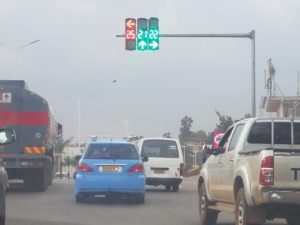Dr. Dylan Bould’s Story – Settling In

This is my second visit to Rwanda, but my first trip was very short and I’ve been getting my bearings as we’ve sorted out the many logistical hurdles of finding a car, house, moving in, getting the kids started in school, visa, medical licensure, and starting work. We’re starting to settle in now, and even have our first visitor come to stay this weekend.
First impressions are good! This is reverse innovation waiting to happen: traffic lights that count down the seconds until the lights change. Would love for these to come to Ontario.

Some things are organized a little differently than expected. The map above is of Kiyovu, as you can see a fairly green part of Kigali where I’m fortunate to live and work, and where the children go to school at Ecole Belge. All the roads winding around this area, and the rest of the city, are named with two letters (according to which part of town you’re in), a number then “street”, “road” or “avenue”. I’ve not worked out yet whether this makes things more or less confusing.
A 4×4 ambulance sounds like a great idea for rural terrains. It’s also essential to have a solid transmission even to pull out of the steep driveway of our home. Rwanda is undersold as the Land of 1000 Hills – it’s all hills.

One of the most striking things I noticed on arrival at CHUK, the main teaching hospital in Kigali, is the scaling up of training here, even since my last visit in January 2017. Three essential things need to happen for a training program to be able to scale up a safe anesthesia workforce: good recruitment, high quality training and finally retention of graduates in the workforce. Recruitment into anesthesia had long been a problem for this program, and the intake from 2006 to 2014 was 2, 0, 2, 4, 3, 2, 5, 0 and 2 residents, a total of 20. The intake from 2015 to 2017 was 10, 9 and 12, a total of 31 in just 3 years, more than quadrupling the annual intake. The room was packed on Monday for the 07:00 debrief of the previous nights cases. We know well of the dire lack of human resources for anesthesia and surgical care globally. Eugene, one of the senior residents, told me today “there is no problem without a solution”. It was fantastic to see the room packed with part of the solution to this particular problem. Although it’s too early for the increase in recruitment to have resulted in increased graduates, it feels like Rwanda is on the cusp of some profound changes to anesthesia and perioperative care.
Another change is in scope. I’m in Rwanda with the HRH (Human Resources for Health) program, and I’m twinned with Dr Paulin Ruhato. Paulin is now the chair of the Department of Anesthesia, Critical Care and Emergency Medicine. In addition to the anesthesia Masters program (for which Paulin is also program director), there’s also 25 residents in the Masters program in Emergency Medicine and 3 visiting HRH faculty to support this, 2 in emergency and one in critical care. There seems to be HRH faculty in almost every specialty, often here for many years. As Paulin’s twin, I’m the associate chair and associate program director – my job is to work with him and support him in the goal to make the department and training program entirely self-sustaining, without requiring external support. Globally emergency medicine is as underdeveloped, if not more underdeveloped as anesthesia. It’s fantastic to see changes on this scale being supported by such a large program, and a privilege to be part of it.

